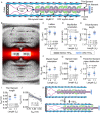This is a preprint.
Titin-based force regulates cardiac myofilament structures mediating length-dependent activation
- PMID: 38014235
- PMCID: PMC10680614
- DOI: 10.1101/2023.11.09.566413
Titin-based force regulates cardiac myofilament structures mediating length-dependent activation
Abstract
The Frank-Starling law states that the heart's stroke volume increases with greater preload due to increased venous return, allowing the heart to adapt to varying circulatory demands. Molecularly, increasing preload increases sarcomere length (SL), which alters sarcomere structures that are correlated to increased calcium sensitivity upon activation. The titin protein, spanning the half-sarcomere, acts as a spring in the I-band, applying a SL-dependent force suggested to pull against and alter myofilaments in a way that supports the Frank-Starling effect. To evaluate this, we employed the titin cleavage (TC) model, where a tobacco-etch virus protease recognition site is inserted into distal I-band titin and allows for rapid, specific cleavage of titin in an otherwise-healthy sarcomere. Here, we evaluated the atomic-level structures of amyopathic cardiac myofilaments following 50% titin cleavage under passive stretch conditions using small-angle X-ray diffraction, which measures these structures under near-physiological (functional) conditions. We report that titin-based forces in permeabilized papillary muscle regulate both thick and thin myofilament structures clearly supporting titin's role in the Frank-Starling mechanism.
Conflict of interest statement
Disclosures: TCI provides consulting and collaborative research studies to Edgewise Therapeutics Inc., ALH and MNK are owners of Accelerated Muscle Biotechnologies Consultants LLC, and WAL provides consulting and collaborative research studies to Dewpoint Therapeutics and Myrtil Biotech (KSILINK-Myriamed), but such work is unrelated to the content of this article. Other authors declare that they have no competing interests.
Figures

References
Publication types
Grants and funding
LinkOut - more resources
Full Text Sources
